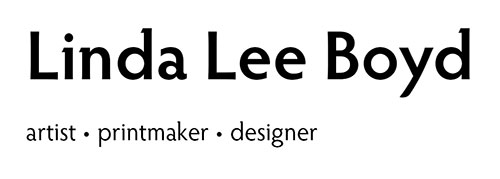|
Reviews
From the catalogue for the Workers and Portraits show at the Fetterly Gallery, November 2001 - January 2002:
Linda Lee Boyd’s woodcut
prints are a continuation of the figurative tradition. The eight portrait
pieces
are very much concerned with the sense and feeling of the figure posed
in relation to its surroundings, whether the setting is a garden, a coastal
landscape, or just a patterned background. The identity of the sitter
is
in many ways defined by the pose and the space it occupies.
The seven “worker” pieces
are also about the figure; in motion, at work, pushing against the inertia
of inanimate
wood, concrete, or steel. These men are defined by their surroundings and
what they do. Yet clearly these are also specific individuals, portraits
of actual persons, and probably known personally to the artist.
The most salient quality
of Boyd’s woodcuts, aside from their technical finesse, is their personalness. We aren’t looking for grand statements, self-conscious art historical references, or cosmic truth with a capital “T” here. What we are seeing is the quiet yet studied and thoughtful work of an artist who lives in an ordinary, day-to-day world inhabited by ordinary, day-to-day people. However, Boyd is not making a statement about or concerning ordinariness per se. The various subjects were chosen and then rendered through a time-consuming and labor-intensive process of woodblock printing to become anything but ordinary. These plasterers and cement workers, uncles, colleagues, and friends with their dogs, by Boyd’s creative vision, have become the most special people on the earth, sort of “working class heroes,” if you will. They quietly and definitively exist in the hushed world of the picture plane, where their “stop action” lives engage the viewer in a special way. We look at them as images that have been transformed by the artist into idiosyncratic icons of everyone’s
day-to-day existence.
The sense of photography is strong in these pieces partly because the images were born from the camera, but also the realism in style and the strong contrast of black and white contribute to this being so. The austere use of color serves to define areas of composition and is not at all descriptive or naturalistic. Where color is used it reinforces the photographic quality of the work by registering as a kind of sepia tone.
Boyd’s technical abilities as an artist are readily apparent; her work has been described as “sonnets in wood.” It
is perhaps her ability to take her friends and co-workers and create poetry
from them that is her highest achievement.
—Daniel Robeski, Curator
and Director of the Fetterly Gallery
Reviews
“Following the path
of the social realists, Linda Lee Boyd, in her richly crafted pictures
of
working class men (Pouring Concrete I), speaks sonnets on the nobility
of work. Boyd’s unsurpassed technical brilliance convinces the viewer that she
practices the ethic her images ennoble. The textural richness of these works
makes it difficult to believe they are crafted from that oldest of printmaking
media, the woodcut.”
From a review by Louis Girling of the California Society of Printmakers
show “On
the Edge of the Century: Printmaking and Social Commentary in the 1990s,” an
exhibition of prints in many media, juried by Rene Yanez and hosted by the
Berkeley Art Center in June 1999. This review was published in the October
1999 issue
of The California Printmaker.
“Linda Lee Boyd’s realistic woodcuts have a somber charm that communicates a
high degree of respect for the materials and techniques of printmaking. Her portraits
and images of workers are rendered in elegant detail. The uncompromising realism
of these prints suggests that part of their message is found in the joy of creating
a mirror of reality. And yet woodcut is such a strangely blunt tool to hold up
as a mirror. The lack of tonality in woodcut, as well as the finality of cutting
are just a few of the problems. Since the media of woodcut is so unforgiving
in creating realism one might wonder why the artist has chosen this medium.…It
must be that woodcut has a special power over the artist which is somehow connected
to the meaning of her prints.…At their best these prints summon up both an intimacy
and an unpretentious world of work and friendship where questions on the nature
of our lives are posed without bombast or pretense, where life is lived with
the dignity that work and the satisfaction of artistry brings.”
From a review by Art Hazelwood of the show “Workers and Portraits,” an exhibition
of prints at the Fetterly Gallery, Vallejo Community Arts Foundation. This review
was published in the 2001 issue of the California Society of Printmakers’ The
California Printmaker.
|
